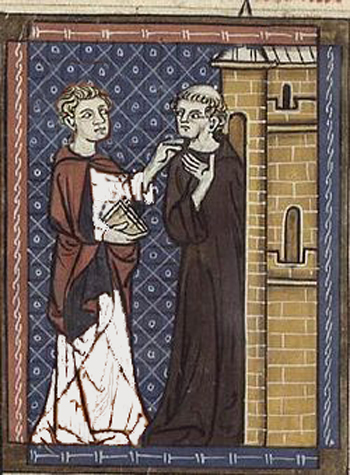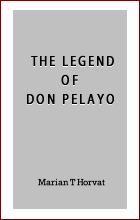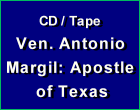Stories & Legends
 |
 |
 |
 |
 |
 |
 |
A Promise Fulfilled
A Dominican religious lived a holy life in his convent at Zamora, a city of the Kingdom of Leon. He was united in the bonds of a pious friendship with a Franciscan brother like himself, a man of great virtue.
 One day, when conversing together on the subject of eternity, they mutually promised that, if it pleased God, the first who died should appear to the other to give him some salutary advice. The Friar Minor died first and one day, while his Dominican friend was preparing the refectory, he appeared to him.
One day, when conversing together on the subject of eternity, they mutually promised that, if it pleased God, the first who died should appear to the other to give him some salutary advice. The Friar Minor died first and one day, while his Dominican friend was preparing the refectory, he appeared to him.
After saluting him with respect and affection, he told him that he was among the elect, but that before he could be admitted to the enjoyment of eternal happiness, there remained much to be suffered for an infinity of small faults of which he had not sufficiently repented during his life.
"Nothing on earth," he added, "can give an idea of the torments which I endure, and of which God permits me to give you a visible proof."
Saying these words, he placed his right hand upon the table of the refectory, and the mark remained impressed upon the charred wood as though it had been applied with a red-hot iron. Such was the lesson which the fervent deceased Franciscan gave to his living friend. It was of profit not only to him, but to all those who came to see the burnt mark, for this table became an object of piety which people came from all parts to look upon.
"It is still to be seen at Zamora" says Father Rossignoli, "at the time I write. To protect it the spot has been covered with a sheet of copper" It was preserved until the end of the last century. Since then it has been destroyed during the revolutions, like so many other religious memorials.
This instance, which happened in Spain, is related in the History of Saint Dominic by Ferdinand of Castile.



A Dominican and Franciscan make a deal
After saluting him with respect and affection, he told him that he was among the elect, but that before he could be admitted to the enjoyment of eternal happiness, there remained much to be suffered for an infinity of small faults of which he had not sufficiently repented during his life.
"Nothing on earth," he added, "can give an idea of the torments which I endure, and of which God permits me to give you a visible proof."
Saying these words, he placed his right hand upon the table of the refectory, and the mark remained impressed upon the charred wood as though it had been applied with a red-hot iron. Such was the lesson which the fervent deceased Franciscan gave to his living friend. It was of profit not only to him, but to all those who came to see the burnt mark, for this table became an object of piety which people came from all parts to look upon.
"It is still to be seen at Zamora" says Father Rossignoli, "at the time I write. To protect it the spot has been covered with a sheet of copper" It was preserved until the end of the last century. Since then it has been destroyed during the revolutions, like so many other religious memorials.
This instance, which happened in Spain, is related in the History of Saint Dominic by Ferdinand of Castile.

Adapted from The Dogma of Purgatory by F. X. Schouppe, SJ,
London: Burns & Oats, 1893, pp. 43-44
Posted November 18, 2017
London: Burns & Oats, 1893, pp. 43-44
Posted November 18, 2017






